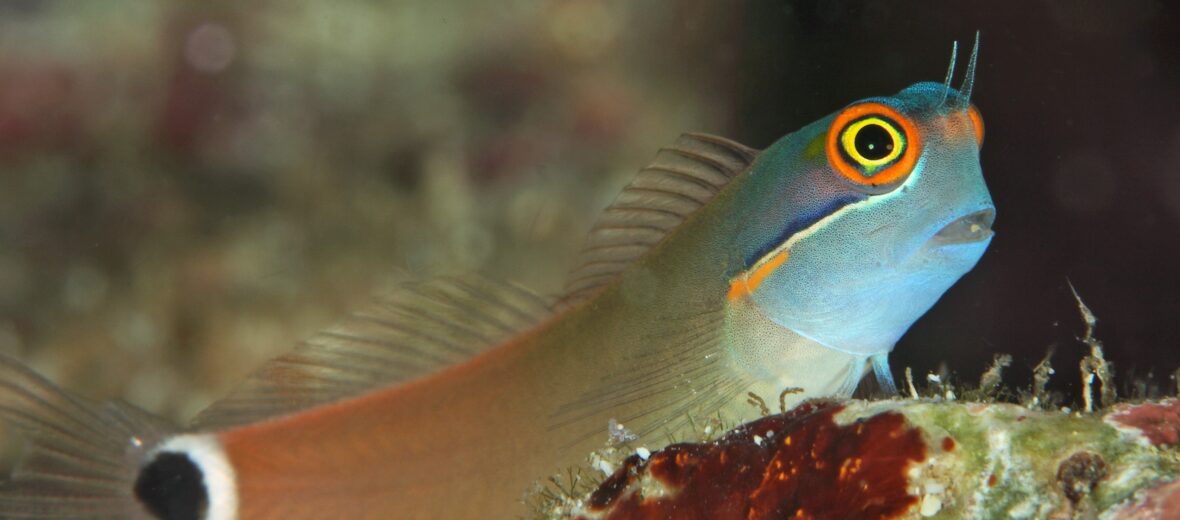
The blenny can be found in oceans all over the world. These critters also come in many sizes and modifications. But 1 thing is for sure, they all have quite the personality. Blennies face a variety of threats from habitat destruction at the hands of the tourism industry, residential and commercial developments, and climate change (which causes warming seas and coral bleaching; over-collection for the pet trade; and pollution. Blenny species are listed anywhere from Data Deficient to Vulnerable, and worse, by the IUCN.
First the Stats…
Scientific name: Blennioidei
Weight: Up to 2+ lbs.
Length: Up to 24+ inches
Lifespan: Up to 15 years
Now on to the Facts!
1.) There are over 700 known species of blennies.
2.) Their personalities vary based on the species. Some are reclusive and shy, while others are bold, defensive, and even aggressive towards other fish & each other.
3.) The colors and patterns are just as diverse, ranging from the expertly camouflaged to the flamboyant.
4.) These critters also have the ability to change their patterns and colors to blend into their surroundings to hide from predators or sneak up on prey.
5.) Food choices vary based on the species. Some like vegetation, some filter feed by sifting detritus (sand), and others hunt invertebrates, like worms and crustaceans.
But wait, there’s more on the blenny!
6.) Some species have elaborate courtship rituals and dances.
7.) Blennies vary in their reproduction. There are some species that engage in internal fertilization, while others are broadcast spawners.
Did you know…?
Some blennies have amazing 360º vision. But all blennies have great eyesight.
8.) There are some species of blenny that will guard and protect their eggs, fanning them to provide oxygen and dusting off algal growth. They even guard the entrance to their burrow to keep the eggs safe.
9.) Blennies have what is called an oral disc. This provides powerful suction that allows them to cling to surfaces in strong currents and can even be used to swipe food from opponents.
10.) Due to their curiosity and inquisitive behaviors, they often will approach divers to get a closer look. They are also not aggressive towards human interactions.
But wait, there’s more on the blenny!
11.) Striped bass, bluefish, weakfish, and others prey on blennies.
12.) These fish are popular aquarium inhabitants, due to their incredible personalities and colorations.
Did you know…?
Amazingly enough, some blennies can actually breath atmospheric oxygen. That is to say they can breathe underwater and out of the water, for a short time.
13.) Mimicry comes natural to many blennies. They are able to copy behaviors and colorations of other fish to aid in camouflage or to avoid predation.
14.) Utilizing their strong bodies and tails, some blennies can jump from the water to escape predation and to move about in shallow tide pools.
15.) Most blennies are very territorial and fiercely guard the entrance to their home against even much larger fish.
But wait, there’s still more on the blenny!
16.) Some blennies are considered fanged blennies. This is due to possessing venomous fangs that are used for self defense and thwarting other blennies.
17.) The venom of fanged blennies can cause a large drop in blood pressure, mild (a subjective term) neurotoxic effects like dizziness, and also inflammation.
Now a Short Blenny Video!
Be sure to share & comment below! Also, check out the Critter Science YouTube channel. Videos added regularly!
Want to suggest a critter for me to write about? Let me know here.
Some source material acquired from: Wikipedia & IUCN
Photo credit: Earth.com



